Canada
Canada Vacation: Breathtaking Scenery
Canada is a beautiful, vast country worthy of exploration, boasting a wide range of extraordinary destinations and experiences. From the captivating charm of Old Quebec City in Montreal, adorned with alluring French architecture, to the sheer magnificence of modern Toronto, to the gorgeeous scenery in beautiful British Columbia and Calgary, there is no shortage of breathtaking sights to behold.
One of the most alluring aspects of Canada is the warm embrace of its diverse cultures. You can immerse yourself in a tapestry of traditions, customs, and culinary delights, all while being greeted by the friendly and welcoming citizens of this great nation. The inclusivity and openness of Canadian society create an environment that fosters a sense of belonging and acceptance.
Here are a few of some of the top destinations in Canada preferred by retirees.
Banff National Park, Alberta:
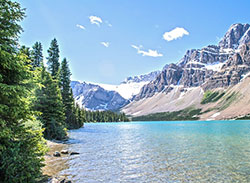
Photo by Pixabay |
For retirees who appreciate the splendor of nature, Banff National Park is a massive, idyllic destination with spectacular scenery. There are many lakes such as beautiful Lake Moraine and Lake Louise. Be awe-struck by glacier-clad mountains and opportunities to spot elk, big horn sheep, grizzly and black bears and 280 species of birds.
|
| Relax and rejuvenate at the Banff Upper Hot Springs, where mineral-rich waters soothe the body and soul. Enjoy a scenic drive along the awe-inspiring Icefields Parkway, taking in panoramic vistas of glaciers, turquoise lakes, and towering mountains. Be sure to stop at Johnston Creek Canyon which has a stunning hiking trail that follows Johnston Creek and leads to two main waterfalls: the gorgeous Lower Falls and the Upper Falls. The trail is well-maintained and offers picturesque views of the canyon walls, lush forests, and the cascading waterfalls.
|
Halifax, Nova Scotia:

Photo by Graham Hobster / Pixabay |
Halifax, a vibrant coastal city, offers a blend of history, maritime heritage, and warm hospitality. Dive into the city's past at the Maritime Museum of the Atlantic, which showcases captivating exhibits on the Titanic and Nova Scotia's seafaring traditions. Explore the charming Peggy's Cove, a picturesque fishing village known for its iconic lighthouse perched atop rugged granite rocks.
|
|
Enjoy leisurely walks along the vibrant waterfront, lined with charming shops, restaurants, and art galleries. Indulge in the freshest seafood, from succulent lobster to mouthwatering oysters. |
Niagara Falls, Ontario:
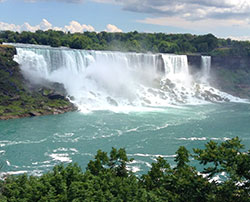
Photo by Enes / Unsplash | Niagara Falls is located in the province of Ontario, Canada. The other side of the falls, is within the United States in New York. The falls themselves form the natural border between the two countries. Niagara Falls is a legendary natural wonder that leaves visitors of all ages awe-inspired. Get up close and personal with the magnificent falls by taking a thrilling boat tour or a mesmerizing helicopter ride.
|
|
While in the region, take the opportunity to explore the scenic beauty of Niagara-on-the-Lake, renowned for its vineyards and wineries. Savor the flavors of local wines through tastings and indulge in culinary delights at charming restaurants. Take a leisurely stroll along the Niagara River Parkway, immersing yourself in the tranquility of the surrounding nature.
|
Ottawa, Ontario:

Photo by Benoit Debaix / Unsplash | As Canada's capital, Ottawa showcases a fascinating blend of history, culture, and natural beauty. Delve into the country's past at the Canadian Museum of History, housing captivating exhibits that trace the nation's heritage. Take a scenic boat cruise along the iconic Rideau Canal, a UNESCO World Heritage Site, and marvel at the picturesque views of the Parliament Buildings and charming canal locks.
|
|
Embrace the vibrant spirit of spring during the Tulip Festival, as millions of tulips bloom throughout the city, celebrating Canada's friendship with the Netherlands. |
Prince Edward Island:
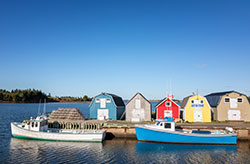
Photo by Rixie / Adobe Stock |
Prince Edward Island, an Atlantic gem is renowned for its welcoming communities, pastoral landscapes, and red sand beaches. Explore the island's picturesque coastal drives, dotted with lighthouses and charming fishing villages. Step the world of Anne of Green Gables at Green Gables Heritage Place, immersing yourself in the beloved story of this fictional character.
|
| Unwind on the tranquil Confederation Trail, a converted railway line offering scenic walks or bike rides through serene countryside. Indulge in a traditional lobster feast, savoring the island's most iconic culinary delight. |
Quebec City, Quebec:
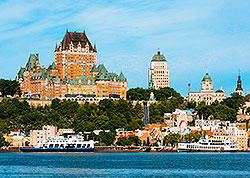
Photo by Joseph Oropel/ Adobe Stock | With its European charm and rich history, Quebec City is a destination that transports visitors to another era. Start your exploration in the UNESCO-listed Old Quebec, where cobblestone streets, quaint shops, and historic architecture await. Marvel at the grandeur of the Château Frontenac, a fairytale-like castle that dominates the skyline. |
|
Visit the awe-inspiring Seville Cathedral, the largest Gothic cathedral in the world, and climb the Giralda tower for breathtaking views of the city. Indulge in traditional Andalusian cuisine, savoring dishes like gazpacho, salmorejo, and tender braised Iberian pork. To fully immerse yourself in the soul-stirring world of flamenco, catch a live performance at one of Seville's intimate tablaos, where the heartfelt melodies and passionate footwork will leave an indelible impression.
|
St. John's, Newfoundland and Labrador:
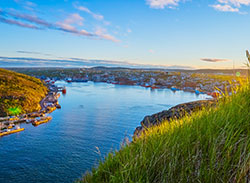
Photo by / |
St. John's, the capital of Newfoundland and Labrador, beckons retirees with its colorful row houses, lively music scene, and rugged coastal landscapes. Wander through the vibrant streets of downtown, admiring the charming Jellybean Row houses. Experience the breathtaking beauty of Cape Spear, the easternmost point in North America, where the Atlantic Ocean crashes against rocky cliffs.
|
| Embark on a boat tour to witness playful puffins and majestic icebergs in their natural habitat. Delight in the local culinary scene, savoring freshly caught seafood and traditional Newfoundland dishes.
|
Vancouver, British Columbia:

Photo by Luke Lawreszuk / Pixabay | Vancouver, located along the Pacific Oceanin British Columbia offers urban excitement, cultural diversity and natural beauty. Immerse yourself in the vibrant atmosphere of Granville Island Public Market, where local vendors offer fresh produce, gourmet treats, and unique handicrafts. Discover the tranquility of Stanley Park as you stroll along the seawall, taking in panoramic views of the city skyline and the surrounding mountains.
|
|
For a cultural experience, visit the renowned Vancouver Art Gallery which has a significant collection of Indigenous art, showcasing the rich artistic traditions and contemporary works of Indigenous artists from Canada and beyond. The gallery's Asian art collection encompasses a wide range of works from different periods and regions of Asia. Music lovers might enjoy a performance by the acclaimed Vancouver Symphony Orchestra, celebrated for its high level of musical excellence and artistic quality. The orchestra comprises highly skilled and talented musicians who perform a wide repertoire of classical, contemporary, and popular music.
|
Victoria, British Columbia:

Narrow Window Photography / Adobe Stock |
Located on Vancouver Island, Victoria is a charming city that combines old-world elegance with natural beauty. Begin your journey with a visit to the iconic Butchart Gardens, where vibrant blooms and meticulously manicured landscapes create a visual feast. Immerse yourself in history at the Royal BC Museum, housing fascinating exhibits on British Columbia's past. |
| Don't miss the chance to indulge in traditional afternoon tea at the iconic Empress Hotel, followed by leisurely walks along the Inner Harbour, offering picturesque views of the city's landmarks. |
Best Time to Visit:
Canada is a vast country with diverse climates, so the best time to visit Canada depends on the region you plan to explore and your preferences for weather and activities. The weather can vary significantly depending on the specific location and year-to-year variations. It's always advisable to check the weather forecasts for your desired destination and time of travel. Here's an overview of each season and the typical temperature ranges you can expect:
Spring (March to May):
Spring in Canada varies across the country. In coastal regions like Vancouver, Spring arrives earlier with mild temperatures ranging from 41°F to 59°F (5°C to 15°C). In central and eastern regions, such as Toronto and Montreal, Spring temperatures can range from (41°F to 68°F (5°C to 20°C). However, snow can still be present in some areas, especially in March.
Summer (June to August):
Summer is a popular time to visit Canada due to the generally pleasant weather. Coastal areas experience mild temperatures, with Vancouver averaging around 68°F to 77°F (20°C to 25°C), while the Atlantic provinces like Halifax have temperatures ranging from 68°F to 86°F (20°C to 30°C). In central and eastern regions, such as Toronto, Montreal, and Ottawa, temperatures can reach 77°F to 95°F (25°C to 35°C), sometimes even higher. The Canadian Rockies offer cooler temperatures ranging from 59°F to 77°F (15°C to 25°C).
Fall (September to November):
Fall brings beautiful foliage as the leaves change colors, making it a picturesque time to visit Canada. The temperatures start to cool down gradually. In coastal areas, such as Vancouver and Halifax, temperatures range from 50°F to 68°F (10°C to 20°C). Central and eastern regions have cooler temperatures, averaging around 50°F to 68°F (10°C to 20°C) in September and dropping to 0°C to 10°C (32°F to 50°F) in November. The Canadian Rockies experience cooler temperatures, ranging from 41°F to 59°F (5°C to 15°C).
Winter (December to February):
Winter in Canada can be quite cold, but it offers unique winter activities and stunning landscapes. In coastal areas like Vancouver, winter temperatures range from 0°C to 10°C (32°F to 50°F), with occasional snowfall. In central and eastern regions, such as Toronto and Montreal, temperatures can range from -10°C to 0°C (14°F to 32°F) and sometimes drop even lower. The Canadian Rockies and northern regions experience colder temperatures, often below freezing, with average temperatures ranging from 5°F to 23°F (-15°C to -5°C).
Travel Planning Tips:
Plan Ahead: Research and plan your itinerary in advance to make the most of your time in Canada. Consider the locations you want to visit, the duration of your stay, and any specific attractions or activities you don't want to miss. Canada is a vast country with diverse landscapes, so prioritize the places you're most interested in exploring.
Currency: Canada uses the Canadian dollar (CAD) as its currency. Make sure to have some Canadian currency for small expenses, but credit cards are widely accepted in most places. Notify your bank or credit card company about your travel plans to avoid any issues with card usage while abroad.
Travel Insurance: Ensure that you have comprehensive travel insurance that covers medical expenses, trip cancellation, and any potential emergencies. Review the policy details and know how to access medical assistance if needed.
Language, Local Customs and Etiquette: Canada is a multicultural country with diverse customs and traditions. English is the predominant language and is widely spoken. Respect local customs and follow etiquette guidelines. Canadians are generally polite and friendly, so embrace the warm hospitality and be considerate of others.
Climate and Weather: Canada experiences different climates across its provinces and territories. Research the weather conditions and pack accordingly. If you're traveling during the winter months, be prepared for cold temperatures and pack appropriate clothing and footwear.
Travel Documents: Ensure you have a valid passport with at least six months' validity remaining. Check if you require a visa to enter Canada, depending on your nationality, and ensure you have all the necessary travel documents. Consider obtaining an Electronic Travel Authorization (eTA) if required.
Accommodation Options:
Canada offers a wide range of accommodation options, including hotels, hostels, vacation rentals, and rural guesthouses. Bed and breakfast establishments offer a more personalized and cozy experience, and the opportunity to interact with the hosts and fellow guests. Renting a vacation home or condo is another popular choice for retirees. This option provides more space, privacy, and a home-like environment. Vacation rentals often come equipped with kitchens, laundry facilities, and other amenities. Other options to considder are RV parks or campgrounds. Canada offers numerous scenic camping destinations with facilities for RVs and campers which is a good choice for those who wish to explore different regions, enjoy nature, and connect with other travelers.
Transportation:
Canada has an extensive transportation network that includes various modes of transportation. It's important to note that the availability and accessibility of transportation options may vary depending on the specific region or city you're visiting in Canada. Research your destinations beforehand to understand the local transportation infrastructure and plan accordingly. Consider the following options when planning your travels within the country:
- Domestic Flights: If you're traveling long distances within Canada, domestic flights can provide faster connections. Major cities have airports served by full-service and low-cost airlines, offering domestic routes. Research different airlines and compare prices to find the most convenient and cost-effective options.
- Trains: Canada has a well-established passenger train network operated by VIA Rail. While not as extensive as in some other countries, train travel can be a scenic and comfortable way to explore certain regions, such as the Rocky Mountains or the Maritime provinces. VIA Rail offers various classes of service, including sleeper cabins for overnight journeys.
- Buses: Intercity bus services are available in Canada, connecting different cities and towns. Greyhound is a prominent intercity bus operator, but there are also regional and local bus companies serving specific areas. Buses can be an economical option for shorter distances or destinations with limited train or air service.
- Rental Cars: Renting a car can be a practical choice for exploring Canada, especially if you plan to visit rural areas or smaller towns. Major car rental companies have offices in airports and urban centers. Familiarize yourself with traffic rules, road conditions, and any additional requirements such as winter tires or permits for certain national parks.
- Taxis:Taxis are available in urban areas of Canada, and you can typically find them at designated taxi stands or hail them on the street. In recent years, rideshare services such as Uber and Lyft have also become popular in some cities. Check the availability and regulations of rideshare services in your specific destination.
- Public Transportation:
Canada's major cities have comprehensive public transportation systems, including buses, metros (subways), and light rail systems (where available). These systems are generally efficient and convenient for getting around urban areas. Consider purchasing travel cards or individual tickets based on your expected usage.
Safety Tips:
- Personal Safety: Canada is considered a safe destination, but it's always wise to take precautions. Be aware of your surroundings, keep your valuables secure, and avoid isolated or unfamiliar areas, especially at night.
- Vaccinations: Check with your healthcare provider or travel clinic about recommended vaccinations before visiting Canada. These may include vaccinations for COVID-19, measles, mumps, rubella, diphtheria, tetanus, pertussis, polio, influenza, and others, depending on your age, health condition, and vaccination history.
- Prescription Medications: If you have any pre-existing medical conditions or require regular medications, consult with your healthcare provider before your trip. Make sure you have an ample supply of prescription medications for the duration of your stay, along with copies of your prescriptions. Familiarize yourself with the healthcare system in Canada and know how to seek medical assistance if required.
- Emergency Numbers: In Canada, the emergency phone number to call for police, fire, or ambulance is 911. This number is widely recognized and used throughout the country for any emergency situation that requires immediate assistance. When dialing 911, be prepared to provide your location and a brief description of the emergency to the operator.
- Travel Advisories Stay updated on current events, local regulations, and any travel advisories when traveling abroad. Visit the US Government State Department Travel Advisories web site to check on the status of your destination.
- Enroll in the STEP Program: Travelers are also urged to enroll in the U.S. State Department's Smart Traveler Enrollment Program (STEP) to receive security messages and to make it easier to locate them in an emergency. The Department uses these security messages to convey information about terrorist threats, security incidents, planned demonstrations, natural disasters, etc. In an emergency, please contact the nearest U.S. Embassy or consulate or call the following numbers: 1 (888) 407-4747 (toll-free in the United States and Canada) or 1 (202) 501-4444 from other countries.
| |
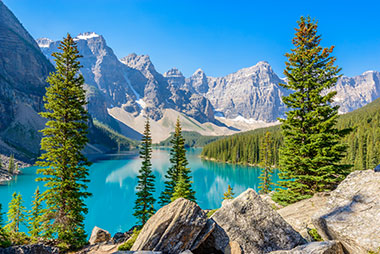 Lake Moraine, Banff Photo by Karamysh / Adobe Stock
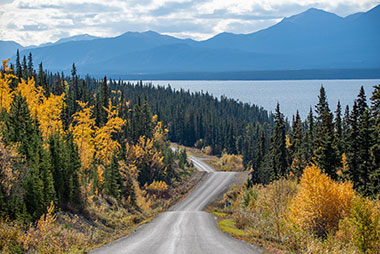 British Columbia Photo by Scalia Media / Adobe Stock
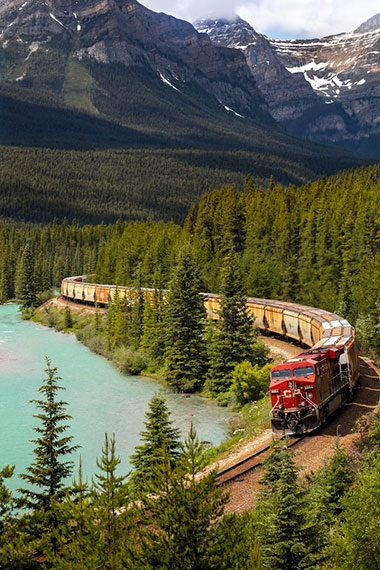 Canadian railway Photo by Andy Holmes / Umsplash
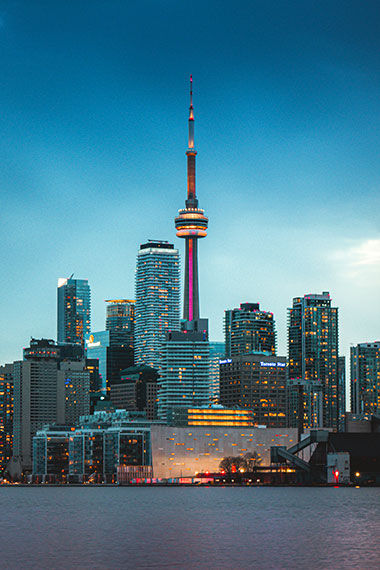 Toronto skyline
Photo by Juan Rojas- / Unsplash
|
 Lake Moraine, Banff
Lake Moraine, Banff Canadian railway
Canadian railway